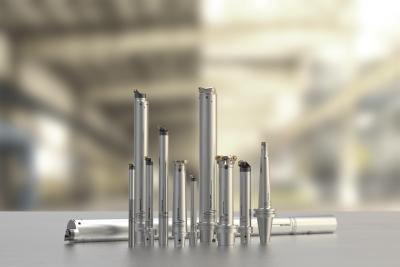
Seco Tools has expanded its long-reach turning and boring solutions with additions to its series of Steadyline vibration-damping turning/boring bars and their respective heads. The new additions include 1.00" (25 mm) diameter Steadyline bars, GL25 turning heads and 4.00" (100 mm) diameter Steadyline bars, along with a range of rough and fine boring heads for Steadyline bars. Where conventional solutions fail, Steadyline delivers accuracy and confidence in long overhang operations, reducing spindle stress, increasing metal-removal rates, creating smooth surface finishes and extending tool life.
Steadyline turning bars use an effective passive damping system for easy turning and boring operations to depths up to 10xD in small and large holes. A dynamic passive system acts as antiresonance inside the holder's body as a damped mass counter vibrates against the first vibration. Working together with the Steadyline damping system, the short, compact GL heads maximize vibration absorption, making it possible to use extended lengths without tool chatter or work interruptions.
With Steadyline, users can exchange turning and boring tool heads quickly and effortlessly using the unique Seco GL connection. The GL connection mounts heads to Steadyline bars quickly and firmly, with centering accuracy and repeatability of 5 microns and 180° head orientation capability if required.
The 1.00" (25 mm) diameter bars with GL25 workpiece-side connection for 6xD, 8xD and 10xD reaches include carbide-reinforced bars for the deepest tool overhang challenges, along with Seco-Capto, HSK-T/A and cylindrical shank machine-side interfaces.
The 16 new GL25 turning heads target applications including general turning, recessing and back boring with DN..11, CC..09, DC..07, DC..11, TC..11 and VB..11 inserts.
Larger 4.00" (100 mm) diameter bars accommodate existing GL50 turning heads and incorporate Jetstream Tooling high-pressure coolant technology through BA-to-GL50 adapters.
Boring heads with BA060 and BA080 machine-side connections allow for rough and fine boring at diameters from 2.60" to 4.53" (66 mm to 115 mm).
Contact Details
Related Glossary Terms
- boring
boring
Enlarging a hole that already has been drilled or cored. Generally, it is an operation of truing the previously drilled hole with a single-point, lathe-type tool. Boring is essentially internal turning, in that usually a single-point cutting tool forms the internal shape. Some tools are available with two cutting edges to balance cutting forces.
- centering
centering
1. Process of locating the center of a workpiece to be mounted on centers. 2. Process of mounting the workpiece concentric to the machine spindle. See centers.
- chatter
chatter
Condition of vibration involving the machine, workpiece and cutting tool. Once this condition arises, it is often self-sustaining until the problem is corrected. Chatter can be identified when lines or grooves appear at regular intervals in the workpiece. These lines or grooves are caused by the teeth of the cutter as they vibrate in and out of the workpiece and their spacing depends on the frequency of vibration.
- coolant
coolant
Fluid that reduces temperature buildup at the tool/workpiece interface during machining. Normally takes the form of a liquid such as soluble or chemical mixtures (semisynthetic, synthetic) but can be pressurized air or other gas. Because of water’s ability to absorb great quantities of heat, it is widely used as a coolant and vehicle for various cutting compounds, with the water-to-compound ratio varying with the machining task. See cutting fluid; semisynthetic cutting fluid; soluble-oil cutting fluid; synthetic cutting fluid.
- recessing
recessing
A turning operation in which a groove is produced on the periphery or inside a hole of a workpiece. The grooving tool moves at right angles to the axis of rotation.
- shank
shank
Main body of a tool; the portion of a drill or similar end-held tool that fits into a collet, chuck or similar mounting device.
- turning
turning
Workpiece is held in a chuck, mounted on a face plate or secured between centers and rotated while a cutting tool, normally a single-point tool, is fed into it along its periphery or across its end or face. Takes the form of straight turning (cutting along the periphery of the workpiece); taper turning (creating a taper); step turning (turning different-size diameters on the same work); chamfering (beveling an edge or shoulder); facing (cutting on an end); turning threads (usually external but can be internal); roughing (high-volume metal removal); and finishing (final light cuts). Performed on lathes, turning centers, chucking machines, automatic screw machines and similar machines.

